Measuring Compound Soil Erosion by Wind and Water in the Eastern Agro–Pastoral Ecotone of Northern China
Abstract
:1. Introduction
2. Materials and Methods
2.1. Study Area
2.2. Data
2.3. Methodology
2.3.1. Water Erosion Model
| Factor | Formulas | References | |
|---|---|---|---|
| Rainfall erosivity (R) | (2) | [43] | |
| (3) | |||
| (4) | |||
| (5) | |||
| (6) | |||
| Topographic (LS) | (7) | [44] | |
| Vegetation cover (B) | (8) | [32] | |
| (9) | |||
| (10) | |||
| (11) | |||
| (12) | |||
| (13) | |||
| Soil erodibility (K) | (14) | [45] | |
| (15) |
2.3.2. Wind Erosion Model
| Factor | Formulas | References | |
|---|---|---|---|
| Wind erosion climate (WF) | (19) | [46] | |
| (20) | |||
| (21) | |||
| Surface roughness (K′) | (22) | [48] | |
| (23) | |||
| Comprehensive vegetation (C) | (24) | [49] | |
| Soil erodibility (EF) | (25) | [46] | |
| Soil crust (SCF) | (26) | [46] |
2.3.3. Estimation of CSE
2.3.4. Mapping the Distribution of Soil Erosion Types
2.3.5. Assessing Classification Accuracy of Soil Erosion Types
2.3.6. Validation of the Soil Erosion Results
3. Results
3.1. Soil Erosion Intensity
3.2. Soil Erosion Type Distribution
3.3. Validation of Water Erosion
3.4. Validation of Wind Erosion
3.5. Validation of CSE
4. Discussion
4.1. Effectiveness and Seasonality of CSE
4.2. The Contribution of This Study to Soil Erosion Research
4.3. Uncertainty of Effects of Wind-on-Water and Water-on-Wind
5. Conclusions
Author Contributions
Funding
Institutional Review Board Statement
Informed Consent Statement
Data Availability Statement
Conflicts of Interest
References
- Bridges, E.; Oldeman, L. Global assessment of human-induced soil degradation. Arid Soil Res. Rehabil. 1999, 13, 319–325. [Google Scholar] [CrossRef]
- Ganasri, B.P.; Ramesh, H. Assessment of soil erosion by RUSLE model using remote sensing and GIS—A case study of Nethravathi Basin. Geosci. Front. 2016, 7, 953–961. [Google Scholar] [CrossRef] [Green Version]
- Vanwalleghem, T. Soil Erosion and Conservation; John Wiley & Sons, Ltd.: Hoboken, NJ, USA, 2017. [Google Scholar]
- Lu, R.; Liu, Y.F.; Jia, C.; Huang, Z.; Liu, Y.; He, H.H.; Liu, B.R.; Wang, Z.J.; Zheng, J.Y.; Wu, G.L. Effects of mosaic-pattern shrub patches on runoff and sediment yield in a wind-water erosion crisscross region. Catena 2019, 174, 199–205. [Google Scholar] [CrossRef]
- Wisniewska, M.; Fijalkowska, G.; Szewczuk-Karpisz, K.; Urban, T.; Nosal-Wiercinska, A.; Wojcik, G. Comparison of adsorption affinity of anionic and cationic polyacrylamides for montmorillonite surface in the presence of chromium (VI) ions. Adsorption 2019, 25, 41–50. [Google Scholar] [CrossRef] [Green Version]
- Han, L.; Pan, Y.W.; Zhu, Z.M.; Fan, J.; Wang, S. The characteristics of soil water and gas transport under different land use patterns in the water-wind erosion crisscross region. J. Appl. Ecol. 2019, 30, 1415–1422. [Google Scholar] [CrossRef]
- Zhang, J.; Yang, M.; Deng, X.; Liu, Z.; Zhang, F. The effects of tillage on sheet erosion on sloping fields in the wind-water erosion crisscross region of the Chinese Loess Plateau. Soil Tillage Res. 2019, 187, 235–245. [Google Scholar] [CrossRef]
- Xu, G.; Tang, S.; Lu, K.; Li, P.; Li, Z.; Gao, H.; Zhao, B. Runoff and sediment yield under simulated rainfall on sand-covered slopes in a region subject to wind-water erosion. Environ. Earth Sci. 2015, 74, 2523–2530. [Google Scholar] [CrossRef]
- Bullard, J.E.; McTainsh, G.H. Aeolian-fluvial interactions in dryland environments: Examples, concepts and Australia case study. Prog. Phys. Geogr. 2003, 27, 471–501. [Google Scholar] [CrossRef]
- Bullard, J.E.; Livingstone, I. Interactions between aeolian and fluvial systems in dryland environments. Area 2002, 34, 8–16. [Google Scholar] [CrossRef]
- Ding, Z.; Zhang, Z.; Li, Y.; Zhang, L.; Zhang, K. Characteristics of magnetic susceptibility on cropland and pastureland slopes in an area influenced by both wind and water erosion and implications for soil redistribution patterns. Soil Tillage Res. 2020, 199, 104568. [Google Scholar] [CrossRef]
- Tuo, D.; Xua, M.; Gao, G. Relative contributions of wind and water erosion to total soil loss and its effect on soil properties in sloping croplands of the Chinese Loess Plateau. Sci. Total Environ. 2018, 633, 1032–1040. [Google Scholar] [CrossRef] [PubMed]
- Zhang, Y.-G.; Nearing, M.A.; Liu, B.Y.; Pelt, R.S.V.; Stone, J.J.; Wei, H.; Scott, R.L. Comparative rates of wind versus water erosion from a small semiarid watershed in southern Arizona, USA. Aeolian Res. 2011, 3, 197–204. [Google Scholar] [CrossRef]
- Zou, Y. Analysis on Driving Forces of Typical Zones Land Use Change in Ecotone between Agriculture and Animal Husbandry and Its Impacts on Soil Erosion. Ph.D. Thesis, University of Chinese Academy of Sciences, Beijing, China, 2003. [Google Scholar]
- Greipsson, S. Catastrophic soil erosion in Iceland: Impact of long-term climate change, compounded natural disturbances and human driven land-use changes. Catena 2012, 98, 41–54. [Google Scholar] [CrossRef]
- Roper, M.M.; Davies, S.L.; Blackwell, P.S.; Hall, D.J.M.; Bakker, D.M.; Jongepier, R.; Ward, P.R. Management options for water-repellent soils in Australian dryland agriculture. Soil Res. 2015, 53, 786–806. [Google Scholar] [CrossRef]
- Tapia, Y.; Diaz, O.; Pizarro, C.; Segura, R.; Vines, M.; Zuniga, G.; Moreno-Jimenez, E. Atriplex atacamensis and Atriplex halimus resist As contamination in Pre-Andean soils (northern Chile). Sci. Total Environ. 2013, 450, 188–196. [Google Scholar] [CrossRef]
- Panagos, P.; Borrelli, P.; Poesen, J.; Ballabio, C.; Lugato, E.; Meusburger, K.; Montanarella, L.; Alewell, C. The new assessment of soil loss by water erosion in Europe. Environ. Sci. Policy 2015, 54, 438–447. [Google Scholar] [CrossRef]
- Panagos, P.; Ballabio, C.; Borrelli, P.; Meusburger, K. Spatio-temporal analysis of rainfall erosivity and erosivity density in Greece. Catena 2016, 137, 161–172. [Google Scholar] [CrossRef]
- Gao, H.; Li, Z.; Jia, L.; Li, P.; Xu, G.; Ren, Z.; Pang, G.; Zhao, B. Capacity of soil loss control in the Loess Plateau based on soil erosion control degree. J. Geogr. Sci. 2016, 26, 457–472. [Google Scholar] [CrossRef] [Green Version]
- Gao, C.; Wei, C.; Zhang, L.; Han, D.; Liu, H.; Yu, X.; Wang, G. Historical (1880s–2000s) impact of wind erosion on wetland patches in semi-arid regions: A case study in the western Songnen Plain (China). Aeolian Res. 2019, 38, 13–23. [Google Scholar] [CrossRef]
- Chappell, A.; Webb, N.P.; Leys, J.F.; Waters, C.M.; Orgill, S.; Eyres, M.J. Minimising soil organic carbon erosion by wind is critical for land degradation neutrality. Environ. Sci. Policy 2019, 93, 43–52. [Google Scholar] [CrossRef]
- Duniway, M.C.; Pfennigwerth, A.A.; Fick, S.E.; Nauman, T.W.; Belnap, J.; Barger, N.N. Wind erosion and dust from US drylands: A review of causes, consequences, and solutions in a changing world. Ecosphere 2019, 10, e02650. [Google Scholar] [CrossRef] [Green Version]
- Jiang, L.; Xiao, Y.; Ouyang, Z.; Xu, W.; Zheng, H. Estimate of the wind erosion modules in Qinghai province based on RWEQ Model. Res. Soil Water Conserv. 2015, 22, 21–32. [Google Scholar]
- Yang, X. Study of soil erosion regionalization and soil loss survey in China. J. Nat. Disasters 2011, 20, 131–136. [Google Scholar]
- Ravi, S.; Breshears, D.D.; Huxman, T.E.; D’Odorico, P. Land degradation in drylands: Interactions among hydrologic–aeolian erosion and vegetation dynamics. Geomorphology 2010, 116, 236–245. [Google Scholar] [CrossRef]
- Tuo, D.; Xu, M.; Ma, X.; Zheng, S. Impact of wind-water alternate erosion on the characteristics of sediment particles. Chin. J. Appl. Ecol. 2014, 25, 381–386. [Google Scholar]
- Yang, H.; Gao, Y.; Lin, D.; Zou, X.; Shi, P. An experimental study on the influences of wind erosion on water erosion. J. Arid Land 2017, 9, 580–590. [Google Scholar] [CrossRef]
- Yang, H.M.; Zou, X.Y.; Wang, J.A.; Shi, P.J. An experimental study on the influences of water erosion on wind erosion in arid and semi-arid regions. J. Arid Land 2019, 11, 208–216. [Google Scholar] [CrossRef] [Green Version]
- Robichaud, P.R.; Jennewein, J.; Sharratt, B.S.; Lewis, S.A.; Brown, R.E. Evaluating the effectiveness of agricultural mulches for reducing post-wildfire wind erosion. Aeolian Res. 2017, 27, 13–21. [Google Scholar] [CrossRef]
- Fister, W.; Iserloh, T.; Ries, J.B.; Schmidt, R.-G.J.C. A portable wind and rainfall simulator for in situ soil erosion measurements. Catena 2012, 91, 72–84. [Google Scholar] [CrossRef]
- Lin, D.; Gao, Y.; Wu, Y.; Shi, P.; Yang, H.; Wang, J.A. A Conversion Method to Determine the Regional Vegetation Cover Factor from Standard Plots Based on Large Sample Theory and TM Images: A Case Study in the Eastern Farming-Pasture Ecotone of Northern China. Remote Sens. 2017, 9, 1035. [Google Scholar] [CrossRef] [Green Version]
- Zhang, G.; Azorin-Molina, C.; Shi, P.; Lin, D.; Guijarro, J.A.; Kong, F.; Chen, D. Impact of near-surface wind speed variability on wind erosion in the eastern agro-pastoral transitional zone of Northern China, 1982–2016. Agric. For. Meteorol. 2019, 271, 102–115. [Google Scholar] [CrossRef]
- Chen, G.; Zhang, Z.; Guo, Q.; Wang, X.; Wen, Q. Quantitative Assessment of Soil Erosion Based on CSLE and the 2010 National Soil Erosion Survey at Regional Scale in Yunnan Province of China. Sustainability 2019, 11, 3252. [Google Scholar] [CrossRef] [Green Version]
- Liu, B.; Zhang, K.; Xie, Y. An empirical soil loss equation. In Proceedings of the 12th International Soil Conservation Organization Conference, Beijing, China, 26–31 May 2002; p. 15. [Google Scholar]
- Fryrear, D.; Bilbro, J.; Saleh, A.; Schomberg, H.; Stout, J.; Zobeck, T.M. RWEQ: Improved wind erosion technology. J. Soil Water Conserv. 2000, 55, 183–189. [Google Scholar]
- Zha, H.; Zhao, X.; Zhang, T.; Zhou, R. Boundary line on agro-pasture zigzag zone in north China and its problems on eco-environment. Adv. Earth Sci. 2002, 17, 739–747. [Google Scholar]
- Lin, D. Research on the Spatio-Temporal Change of Complex Erosion by Wind and Water in Eastern Section of Farming-Pasture Ecotone of Northern China. Ph.D. Thesis, Beijing Normal University, Beijing, China, 2017. [Google Scholar]
- Wischmeier, W.H.; Smith, D.D. Predicting Rainfall Erosion Losses—A Guide to Conservation Planning; Agriculture Handbook; U.S. Department of Agriculture: Washington, DC, USA, 1978; p. 537.
- Shi, W.; Huang, M.; Barbour, S.L. Storm-based CSLE that incorporates the estimated runoff for soil loss prediction on the Chinese Loess Plateau. Soil Tillage Res. 2018, 180, 137–147. [Google Scholar] [CrossRef]
- Zhang, H.; Zhang, R.; Qi, F.; Liu, X.; Niu, Y.; Fan, Z.; Zhang, Q.; Li, J.; Yuan, L.; Song, Y.; et al. The CSLE model based soil erosion prediction: Comparisons of sampling density and extrapolation method at the county level. Catena 2018, 165, 465–472. [Google Scholar] [CrossRef]
- Ministry of Water Resources of China. Bulletin of Soil and Water Conservation of China; Ministry of Water Resources of China: Beijing, China, 2014.
- Zhang, W.; Fu, J. Rainfall Erosivity Estimation Under Different Rainfall Amount. Resour. Sci. 2003, 25, 35–41. [Google Scholar]
- Zhang, H.; Yang, Q.; Li, R.; Liu, Q.; Moore, D.; He, P.; Ritsema, C.J.; Geissen, V. Extension of a GIS procedure for calculating the RUSLE equation LS factor. Comput. Geosci. 2013, 52, 177–188. [Google Scholar] [CrossRef]
- Wang, B.; Zheng, F.; Römkens, M.J. Comparison of soil erodibility factors in USLE, RUSLE2, EPIC and Dg models based on a Chinese soil erodibility database. Acta Agric. Scand. Sect. B–Soil Plant Sci. 2013, 63, 69–79. [Google Scholar] [CrossRef]
- Fryrear, D.W.; Saleh, A.; Bilbro, J.D.; Zobeck, T.M.; Stout, J.E. Field tested wind erosion model. In Proceedings of the International Symposium “Wind Erosion in West Africa: The Problem and Its Control”, Stuttgart, Germany, 5–7 December 1994; Margraf Verlag: Weikersheim, Germany, 1994; p. 343. [Google Scholar]
- Seo, I.W.; Lim, C.S.; Yang, J.E.; Lee, S.P.; Lee, D.S.; Jung, H.G.; Lee, K.S.; Chung, D.Y. An overview of applicability of WEQ, RWEQ, and WEPS models for prediction of wind erosion in lands. Korean J. Agric. Sci. 2020, 47, 381–394. [Google Scholar]
- Smith, F.; Carson, D. Some thoughts on the specification of the boundary-layer relevant to numerical modelling. Bound.-Layer Meteorol. 1977, 12, 307–330. [Google Scholar] [CrossRef]
- Shang, R.; Qi, Y.; Zhao, T.; Ding, G. Field Investigation on the Influence of Vegetation on Wind and Soil Erosion. Res. Soil Water Conserv. 2006, 13, 37–39. [Google Scholar]
- Liu, B.; Zhang, G.; Xie, Y.; Shen, B.; Gu, Z.; Ding, Y.J. Delineating the black soil region and typical black soil region of Northeastern China. Chin. Sci. Bulletin. 2021, 66, 96–106. [Google Scholar] [CrossRef]
- Sui, Y.; Ou, Y.; Yan, B.; Xu, X.; Rousseau, A.N.; Yu, Z.; Ben, B.L. Assessment of Micro-Basin Tillage as a Soil and Water Conservation Practice in the Black Soil Region of Northeast China. PLoS ONE 2016, 11, e0152313. [Google Scholar] [CrossRef] [PubMed]
- Zhang, H.; Zhuang, L. The impact of soil erosion on internal migration in China. PLoS ONE 2019, 14, e0215124. [Google Scholar] [CrossRef]
- Cohen, J.A. A Coefficient of Agreement for Nominal Scales. Educ. Psychol. Meas. 1960, 20, 37–46. [Google Scholar] [CrossRef]
- Ben-David, A. Comparison of classification accuracy using Cohen’s Weighted Kappa. Expert Syst. Appl. 2008, 34, 825–832. [Google Scholar] [CrossRef]
- Kraemer, H.C. Kappa Coefficient. In Wiley StatsRef: Statistics Reference Online; John Wiley & Sons, Ltd.: Hoboken, NJ, USA, 2015. [Google Scholar]
- Saing, Z.; Djainal, H.; Deni, S. Land use balance determination using satellite imagery and geographic information system: Case study in South Sulawesi Province, Indonesia. Geod. Geodyn. 2021, 12, 133–147. [Google Scholar] [CrossRef]
- Water and Soil Conservation Department of the Ministry of Water Resources. Classification Criteria for Soil Erosion (SL190-2007); China Water&Power Press: Beijing, China, 2008; Volume SL190-2007.
- Draut, A.E.J.G. Gully annealing by aeolian sediment: Field and remote-sensing investigation of aeolian-hillslope-fluvial interactions, Colorado River corridor, Arizona, USA. Geomorphology 2014, 220, 68–80. [Google Scholar]
- Gu, Z.; Shi, C.; Yang, H.; Yao, H. Analysis of dynamic sedimentary environments in alluvial fans of some tributaries of the upper Yellow River of China based on ground penetrating radar (GPR) and sediment cores. Quat. Int. 2019, 509, 30–40. [Google Scholar] [CrossRef]
- Mohammed, S.; Abdo, H.G.; Szabo, S.; Pham, Q.B.; Holb, I.J.; Linh, N.T.T.; Anh, D.T.; Alsafadi, K.; Mokhtar, A.; Kbibo, I.; et al. Estimating Human Impacts on Soil Erosion Considering Different Hillslope Inclinations and Land Uses in the Coastal Region of Syria. Water 2020, 12, 2786. [Google Scholar] [CrossRef]
- Mohammed, S.; Hassan, E.; Abdo, H.G.; Szabo, S.; Mokhtar, A.; Alsafadi, K.; Al-Khouri, I.; Rodrigo-Comino, J. Impacts of rainstorms on soil erosion and organic matter for different cover crop systems in the western coast agricultural region of Syria. Soil Use Manag. 2020, 37, 196–213. [Google Scholar] [CrossRef]
- Wu, G.L.; Liu, Y.F.; Cui, Z.; Liu, Y.; Shi, Z.H.; Yin, R.; Kardol, P. Trade-off between vegetation type, soil erosion control and surface water in global semi-arid regions: A meta-analysis. J. Appl. Ecol. 2020, 57, 875–885. [Google Scholar] [CrossRef]
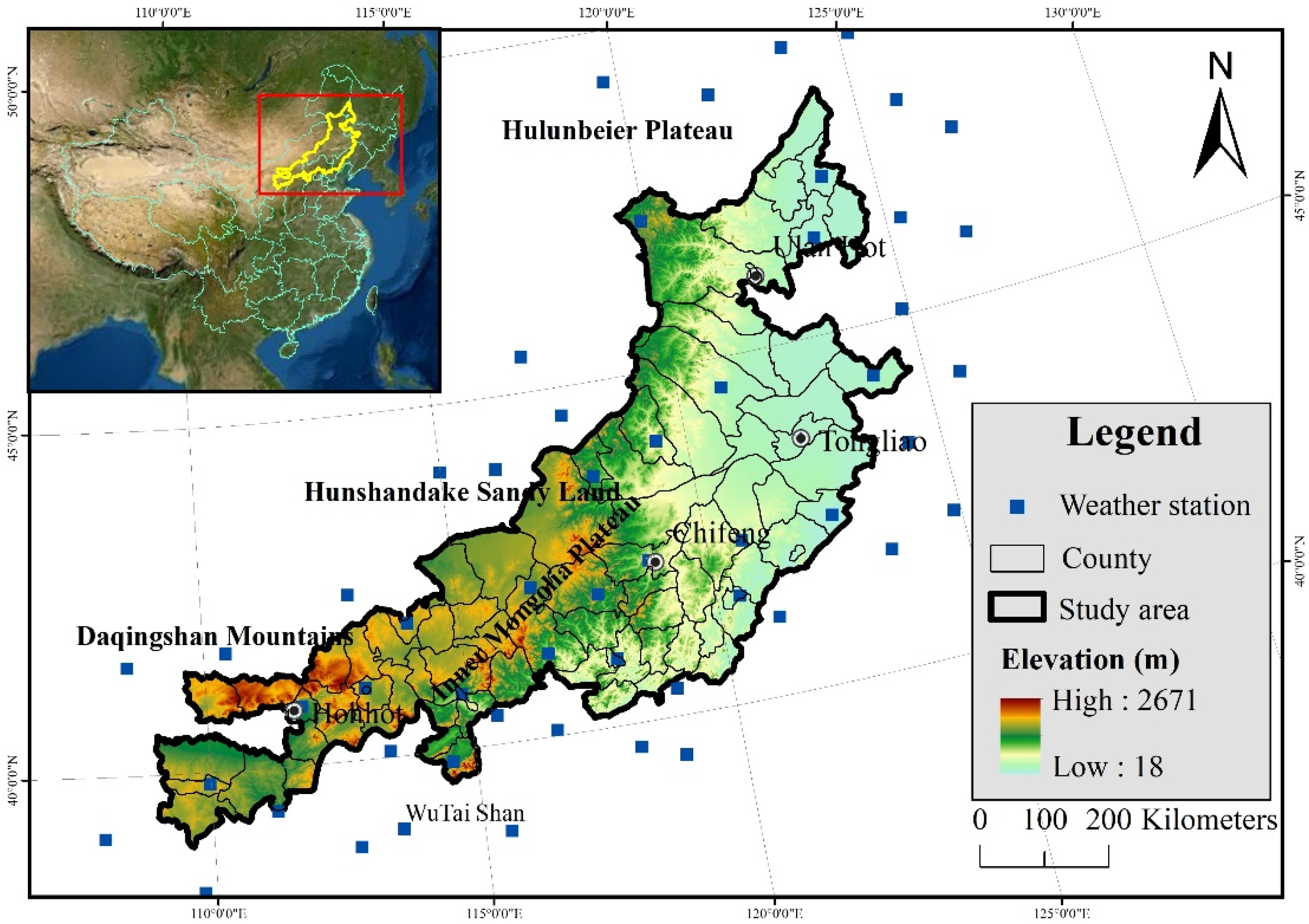



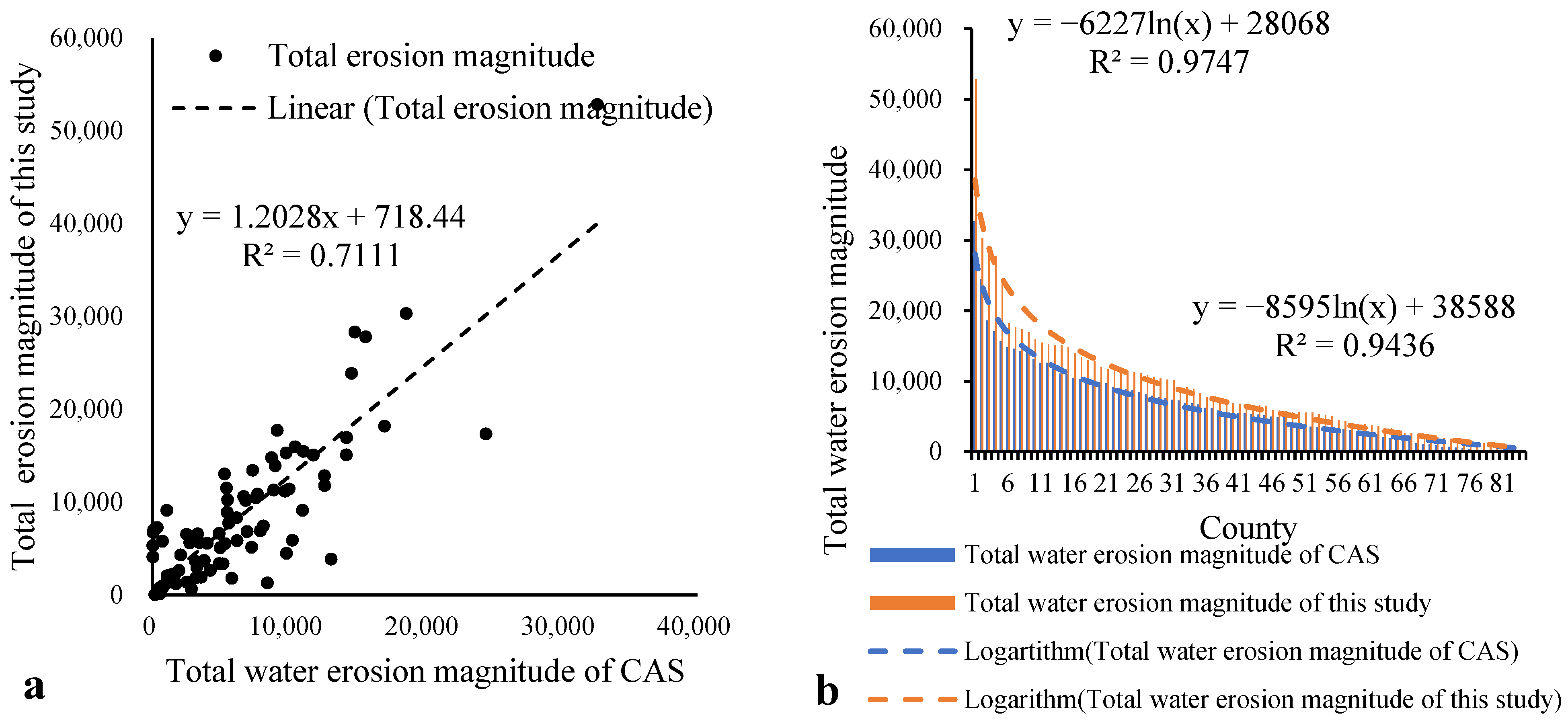


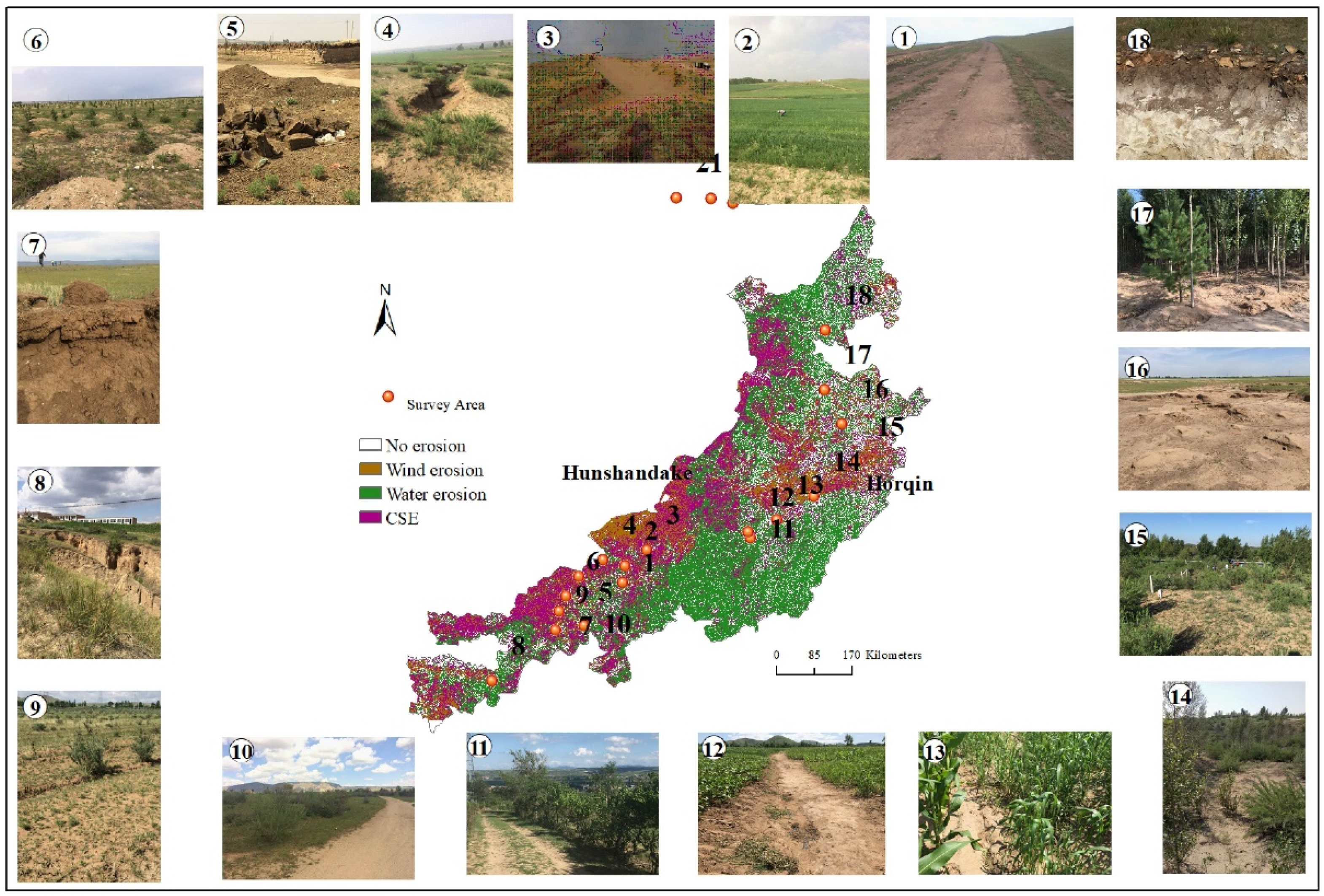

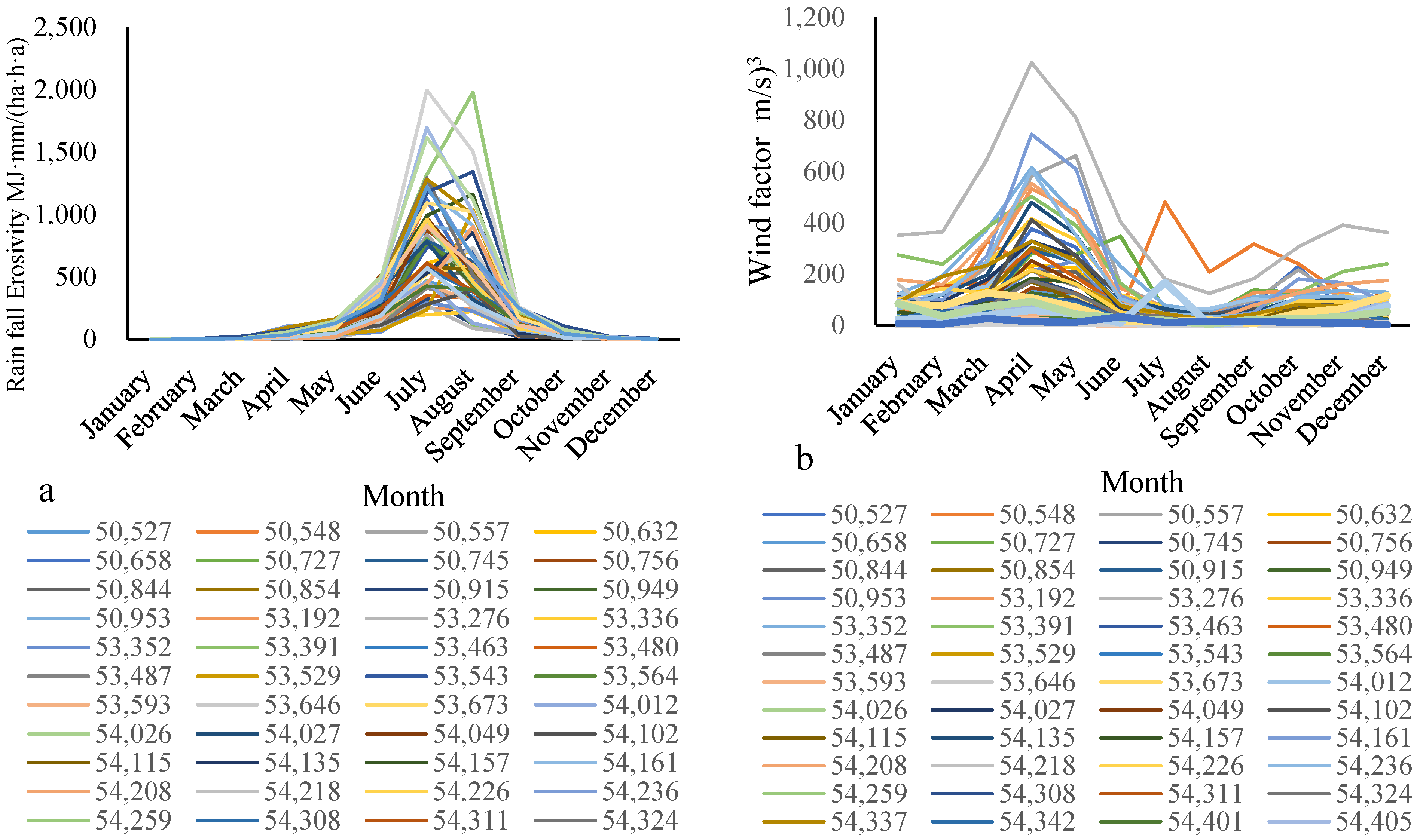
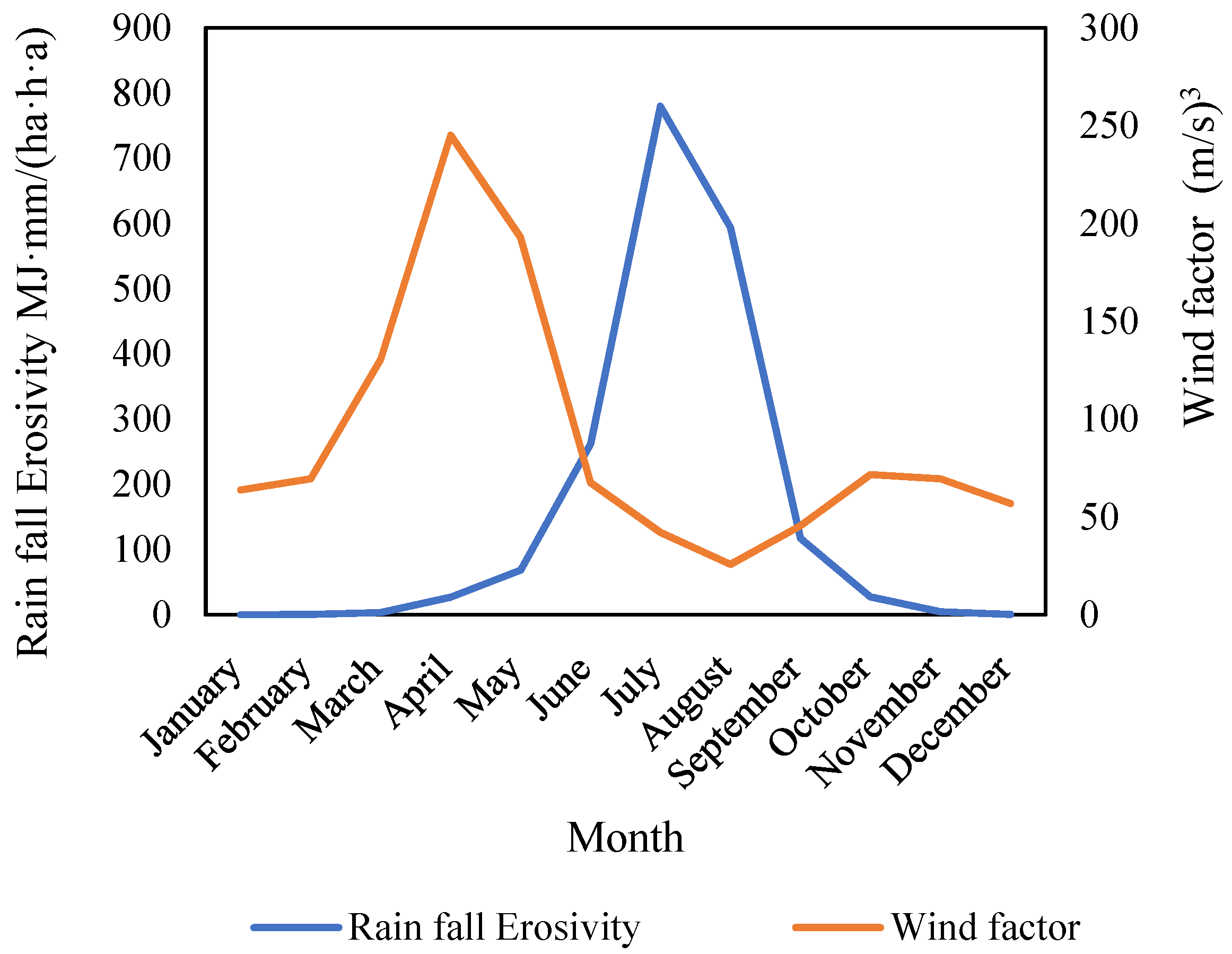

| Type of Data | Data Name | Temporal Resolution | Spatial Resolution | Source |
|---|---|---|---|---|
| Meteorological data | DS3505—Surface Data Hourly Global | 3 h, 1961–2015 | Weather station | NOAA, http://gis.ncdc.noaa.gov/map/viewer/#app=clim&cfg=cdo&theme=hourly&layers=1&node=gis (accessed on 17 May 2022) |
| China surface climate data daily data set (V3.0) | Daily, 1961–2015 | Weather station | China Meteorological Data Service Center (CMDC), http://data.cma.cn/ (accessed on 17 May 2022) | |
| Land use | China Land Use Status Remote Sensing Monitoring Database | 1990, 1995, 2000, 2005 and 2010 | 1 km × 1 km | Resource and Environment Data Cloud Platform, http://www.resdc.cn (accessed on 17 May 2022) |
| Landsat TM images | 2000, 2005, 2010 and 2015 | 30 m × 30 m | USGS. http://earthexplorer.usgs.gov/ (accessed on 17 May 2022) | |
| DEM | Land elevation data | 2005 | 30 m × 30 m | ASTER GDEM, https://earthdata.nasa.gov/ (accessed on 17 May 2022) |
| Soil humidity | This global ECV soil moisture data set | 1978–2014, monthly | 0.25° × 0.25° | European Space Agency, http://www.esa-soilmoisture-cci.org/node/145 (accessed on 17 May 2022) |
| Snow cover | China Snow Deep Time Series Dataset | 1978–2014, daily | 1 km × 1 km | National Cryosphere Desert Data Center. http://www.cryosphere.csdb.cn/portal/metadata/d9a9e8ae-3e8f-4c1a-b1a6-a739a405c971 (accessed on 17 May 2022) |
| Soil | Soil and Terrain Database (SOTER) for China | 2014 | Vector unit | World soil information (ISRIC), https://files.isric.org/public/soter/CN-SOTER.zip (accessed on 17 May 2022) |
| Survey data | The vegetation Coverage in Eastern Section of Farming–Pasture Ecotone of Northern China | 2015–2016 | 1 m × 1 m | Research group of “research on land use and compound soil erosion by wind and water in study area” |
| Erosion verification data | Spatial Distribution Data of Soil Erosion in China | 1995 | 1 km × 1 km | Resource and Environment Data Cloud Platform, http://www.resdc.cn (accessed on 17 May 2022) |
| China Soil and Water Conservation Bulletin | 2004–2015 | Runoff Plots | Ministry of Water Resources, http://www.swcc.org.cn/CountryTopics.asp (accessed on 17 May 2022) |
| Slope(°) | ≤1 | 1–3 | 3–9 | 9–13 | 13–17 | 17–21 | 21–25 | ≥25 |
| Tillage | 0.74 | 0.59 | 0.60 | 0.62 | 0.68 | 0.75 | 0.81 | 0.92 |
| Types | Erosion Rate t km−2 yr−1 | Erosion Area km2 | Proportion of the Study Area % |
|---|---|---|---|
| Water erosion | 4323.67 | 2.63 × 105 | 62.23 |
| Wind erosion | 536.15 | 1.45 × 105 | 34.31 |
| Soil erosion | 4859.96 | 3.486 × 105 | 82.49 |
| Ground-Truthing | |||||||
|---|---|---|---|---|---|---|---|
| No Erosion | Water Erosion | Wind Erosion | CSE | Total | User Accuracy (%) | ||
| Identifying the soil erosion type results | No erosion | 0 | 1 | 0 | 2 | 3 | 0 |
| Water erosion | 0 | 6 | 0 | 0 | 6 | 100 | |
| Wind erosion | 0 | 0 | 3 | 0 | 3 | 100 | |
| CSE | 2 | 0 | 0 | 4 | 6 | 66.67 | |
| Total | 2 | 7 | 3 | 6 | 18 | 72.22 | |
Publisher’s Note: MDPI stays neutral with regard to jurisdictional claims in published maps and institutional affiliations. |
© 2022 by the authors. Licensee MDPI, Basel, Switzerland. This article is an open access article distributed under the terms and conditions of the Creative Commons Attribution (CC BY) license (https://creativecommons.org/licenses/by/4.0/).
Share and Cite
Lin, D.; Shi, P.; Meadows, M.; Yang, H.; Wang, J.; Zhang, G.; Hu, Z. Measuring Compound Soil Erosion by Wind and Water in the Eastern Agro–Pastoral Ecotone of Northern China. Sustainability 2022, 14, 6272. https://doi.org/10.3390/su14106272
Lin D, Shi P, Meadows M, Yang H, Wang J, Zhang G, Hu Z. Measuring Compound Soil Erosion by Wind and Water in the Eastern Agro–Pastoral Ecotone of Northern China. Sustainability. 2022; 14(10):6272. https://doi.org/10.3390/su14106272
Chicago/Turabian StyleLin, Degen, Peijun Shi, Michael Meadows, Huiming Yang, Jing’ai Wang, Gangfeng Zhang, and Zhenhua Hu. 2022. "Measuring Compound Soil Erosion by Wind and Water in the Eastern Agro–Pastoral Ecotone of Northern China" Sustainability 14, no. 10: 6272. https://doi.org/10.3390/su14106272
APA StyleLin, D., Shi, P., Meadows, M., Yang, H., Wang, J., Zhang, G., & Hu, Z. (2022). Measuring Compound Soil Erosion by Wind and Water in the Eastern Agro–Pastoral Ecotone of Northern China. Sustainability, 14(10), 6272. https://doi.org/10.3390/su14106272






